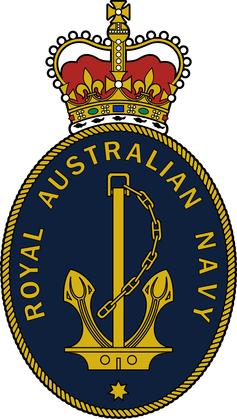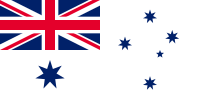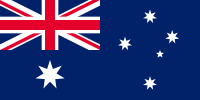Royal Australian Navy facts for kids
Quick facts for kids Royal Australian Navy |
|
|---|---|
 |
|
| Active | 1911–present |
| Country | Australia |
| Type | Navy |
| Size | 13,650 Permanent personnel 2,925 Reserve personnel 46 commissioned ships 3 non-commissioned ships |
| Part of | Australian Defence Force |
| Headquarters | Russell Offices, Canberra |
| Motto(s) | Serving Australia with Pride |
| March | "Royal Australian Navy" |
| Anniversaries | 10 July |
| Engagements | |
| Commanders | |
| Commander-in-chief | General David Hurley (As Governor-General of Australia) |
| Chief of the Defence Force | General Angus Campbell |
| Vice Chief of the Defence Force | Vice Admiral David Johnston |
| Chief of Navy | Vice Admiral Michael Noonan |
| Deputy Chief of Navy | Rear Admiral Mark Hammond |
| Commander Australian Fleet | Rear Admiral Jonathan Mead |
| Insignia | |
| Naval ensign (1967–present) |  |
| Naval jack |  |
| Aircraft flown | |
| Reconnaissance | Sikorsky MH-60R |
| Trainer | Bell 429 GlobalRanger |
| Transport | NHIndustries NH90 |
The Royal Australian Navy (RAN) is Australia's main naval force. It is part of the Australian Defence Force. In 1901, after Australia became a federation, the different ships from the colonial navies joined together. This new national force was first called the Commonwealth Naval Forces.
At first, the navy was only meant for local defence. But in 1911, it was given the name 'Royal Australian Navy'. It then became more important for defending the wider region. The British Royal Navy also helped protect Australia's waters for many years.
During the Second World War, the RAN grew very quickly. It got many large ships and built smaller warships. After the war, the RAN even had a few aircraft carriers. The last one was taken out of service in 1982.
Today, the RAN has 48 active ships and over 16,000 people working for it. It is one of the biggest and most advanced navies in the South Pacific region. The RAN also works in the Indian Ocean and around the world. It helps with military actions and peacekeeping missions. The current leader of the navy is Vice Admiral Michael Noonan.
Contents
The official head of the Royal Australian Navy is the Monarch, currently Queen Elizabeth II. The person who leads the navy day-to-day is the Chief of Navy. This person holds the rank of Vice-Admiral. The navy is managed by the Department of Defence.
The navy has two main parts that help it run:
- Fleet Command – This part is in charge of all the navy's ships and aircraft. It makes sure they are ready for action. The leader of Fleet Command is called the Commander Australian Fleet. This person is a Rear Admiral.
- Navy Strategic Command – This part handles the navy's training, engineering, and supplies. It makes sure sailors are well-trained and that ships are kept in good working order.
Fleet Command used to have seven groups, but now it has four main groups:
- Surface Force: This group looks after the navy's larger ships, like frigates.
- Submarine Force: This group operates the Collins class submarines.
- Mine Warfare, Hydrographic and Patrol Boat Force: This group handles smaller ships. These include patrol boats, ships that map the ocean floor (hydrographic), and ships that deal with mines.
- Fleet Air Arm: This group is responsible for all the navy's aircraft.
Current Missions of the RAN
The Royal Australian Navy is currently involved in several important operations:
- Operation Anode – This is Australia's help for the Regional Assistance Mission in the Solomon Islands.
- Operation Slipper – This is Australia's part in the international fight against terrorism. The RAN usually has one ship in the Persian Gulf for this mission.
- Operation Resolute – This mission helps patrol Australia's waters. The RAN uses at least seven Armidale class patrol boats for this. A larger ship is also kept ready.
RAN Bases Across Australia
The RAN has two main bases for its fleet of ships:
- Fleet Base East, which is at HMAS Kuttabul in Sydney.
- Fleet Base West, which is at HMAS Stirling, near Perth.
There are also other bases for smaller warships, like patrol boats:
- HMAS Coonawarra, in Darwin.
- HMAS Cairns, in Cairns.
- HMAS Waterhen, also in Sydney.
- HMAS Moreton, in Brisbane.
RAN Personnel
As of June 2011, the Royal Australian Navy had 14,215 full-time staff. It also had 2,150 reserve staff. About 18% of the full-time staff were women. The RAN has the highest percentage of women compared to other parts of the Australian Defence Force. Women in the RAN serve in many roles, including combat roles and at sea.
Images for kids
See also
 In Spanish: Armada Real Australiana para niños
In Spanish: Armada Real Australiana para niños





